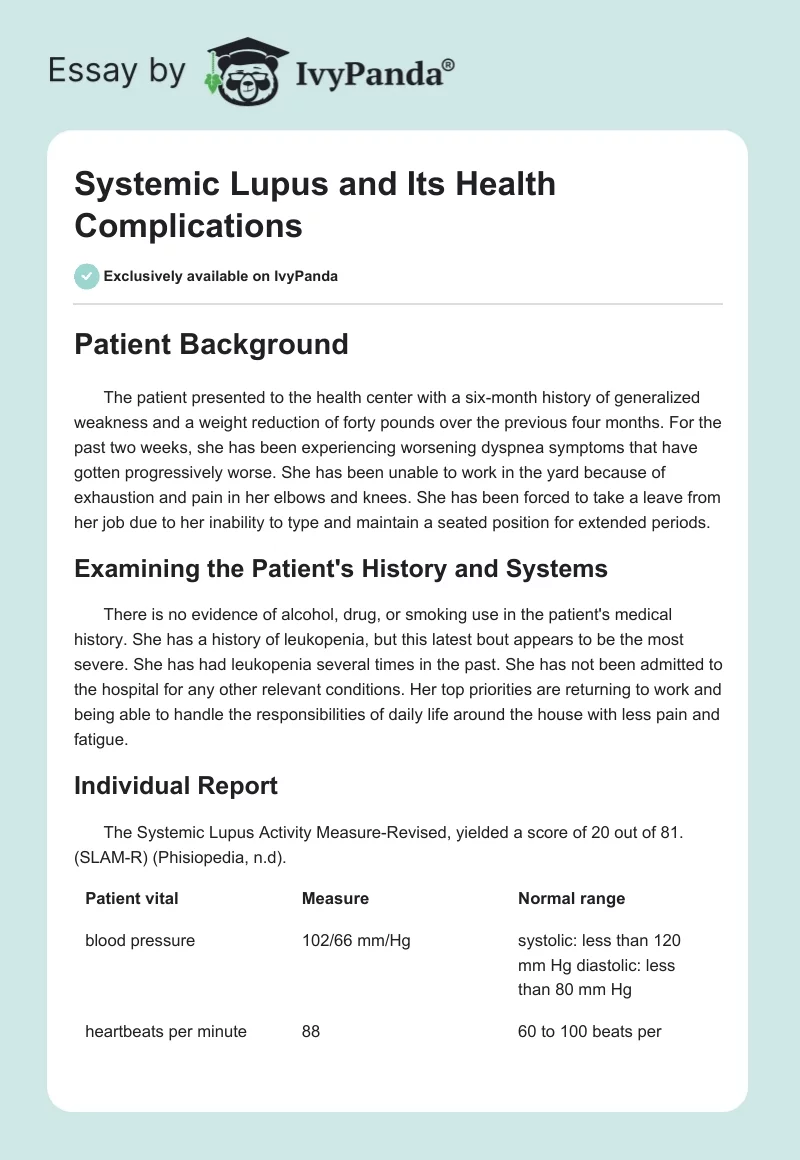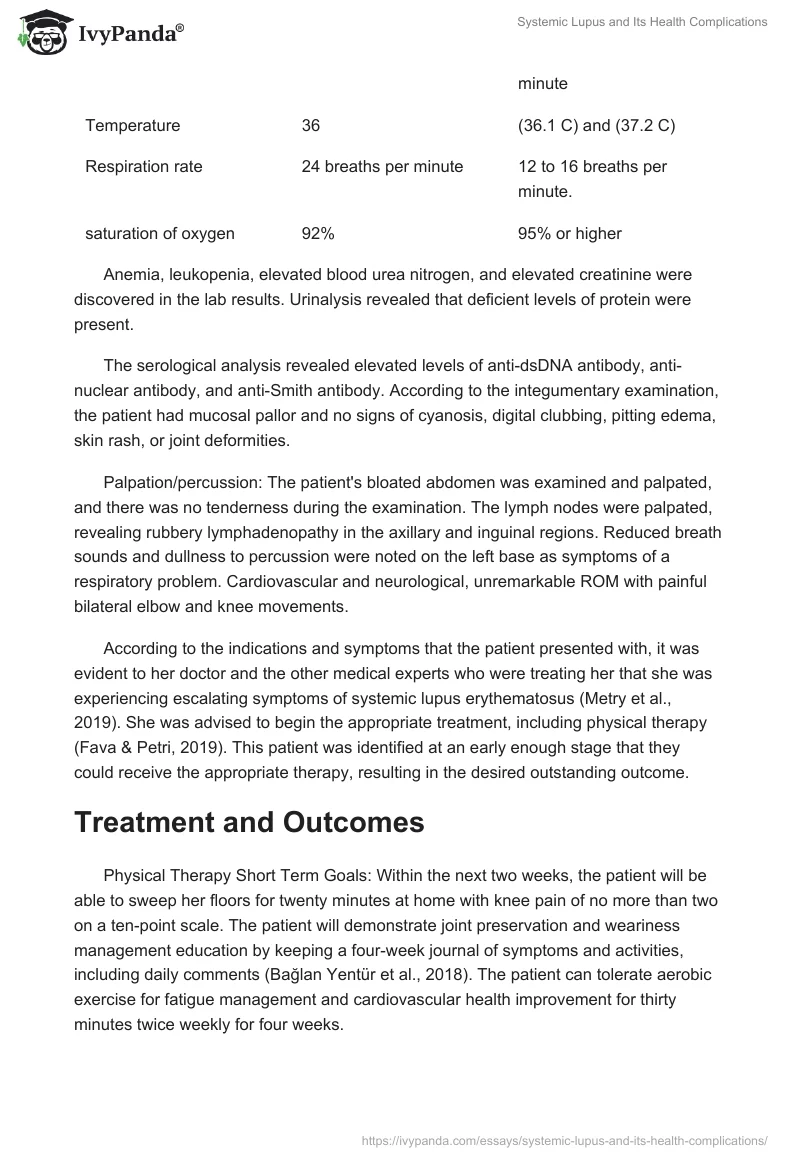Patient Background
The patient presented to the health center with a six-month history of generalized weakness and a weight reduction of forty pounds over the previous four months. For the past two weeks, she has been experiencing worsening dyspnea symptoms that have gotten progressively worse. She has been unable to work in the yard because of exhaustion and pain in her elbows and knees. She has been forced to take a leave from her job due to her inability to type and maintain a seated position for extended periods.
Examining the Patient’s History and Systems
There is no evidence of alcohol, drug, or smoking use in the patient’s medical history. She has a history of leukopenia, but this latest bout appears to be the most severe. She has had leukopenia several times in the past. She has not been admitted to the hospital for any other relevant conditions. Her top priorities are returning to work and being able to handle the responsibilities of daily life around the house with less pain and fatigue.
Individual Report
The Systemic Lupus Activity Measure-Revised, yielded a score of 20 out of 81. (SLAM-R) (Phisiopedia, n.d).
Anemia, leukopenia, elevated blood urea nitrogen, and elevated creatinine were discovered in the lab results. Urinalysis revealed that deficient levels of protein were present.
The serological analysis revealed elevated levels of anti-dsDNA antibody, anti-nuclear antibody, and anti-Smith antibody. According to the integumentary examination, the patient had mucosal pallor and no signs of cyanosis, digital clubbing, pitting edema, skin rash, or joint deformities.
Palpation/percussion: The patient’s bloated abdomen was examined and palpated, and there was no tenderness during the examination. The lymph nodes were palpated, revealing rubbery lymphadenopathy in the axillary and inguinal regions. Reduced breath sounds and dullness to percussion were noted on the left base as symptoms of a respiratory problem. Cardiovascular and neurological, unremarkable ROM with painful bilateral elbow and knee movements.
According to the indications and symptoms that the patient presented with, it was evident to her doctor and the other medical experts who were treating her that she was experiencing escalating symptoms of systemic lupus erythematosus (Metry et al., 2019). She was advised to begin the appropriate treatment, including physical therapy (Fava & Petri, 2019). This patient was identified at an early enough stage that they could receive the appropriate therapy, resulting in the desired outstanding outcome.
Treatment and Outcomes
Physical Therapy Short Term Goals: Within the next two weeks, the patient will be able to sweep her floors for twenty minutes at home with knee pain of no more than two on a ten-point scale. The patient will demonstrate joint preservation and weariness management education by keeping a four-week journal of symptoms and activities, including daily comments (Bağlan Yentür et al., 2018). The patient can tolerate aerobic exercise for fatigue management and cardiovascular health improvement for thirty minutes twice weekly for four weeks.
Physical Therapy Long Term Goals: Within four weeks, the patient will improve their sit-to-stand time from five repetitions to ten repetitions in thirty seconds to improve function in their lower extremities (BAĞLAN YENTÜR et al., 2018). During the next six weeks, the patient will raise their SLAM-R score from 20/81 to 45/81, which will slow the progression of the disease. Within six weeks, the patient will be able to increase their strength in knee extension from 3+/5 to 4+/5, which will help avoid osteoporosis and poor motor function (Chen et al., 2020). Patient was advised to continue her therapeutic intervention twice a week. Her schedule included aquatic aerobics for 30 minutes, bilateral hamstring stretches, squats with diaphragmatic breathing, bicep curls with eight pounds or sixty percent of their one-repetition maximum, and side-lying hip abduction for three sets of twenty. She was instructed to continue with therapy 2-3 times per week for 30 minutes utilizing resistive weights, squat with appropriate mechanics 2×20 10 lb weights with diaphragmatic breathing, biceps curls 2×15 12 lb weights, and standing hip abduction with 3×10 blue theraband. The patient was remissive at the time of discharge and had gained complete relief from pain in both knees and elbows. The Systemic Lupus Activity Measure-Revised yielded a score of 50 out of 81. (SLAM-R).
Discussion
Systemic lupus erythematosus, also known as SLE, is distinguished by the dysfunction of T cells, B cells, and dendritic cells; the release of pro-inflammatory nuclear materials from necrotic cells. The formation of antinuclear antibodies (ANA) and immune complexes of ANA with DNA, RNA, and nuclear proteins; and the release of nuclear materials that contribute to inflammation from necrotic cells (Dahlström & Sjöwall, 2019). Inflammation and abnormalities in the blood vessels, such as band or occlusive vasculopathy, vasculitis, and immune complex deposition, are the hallmarks of systemic lupus erythematosus (SLE) is a chronic autoimmune disease (Di Matteo et al., 2021). Renal pathology is the one that has been studied and characterized the most. It is helpful to educate the patient on the importance of maintaining their exercise routine after they have been discharged from physical therapy treatment (Elera-Fitzcarrald et al., 2018). Getting enough exercise consistently can help reduce weariness as well as joint stiffness. In addition, regular physical activity of moderate intensity helps protect against the adverse effects of stress on the neuroendocrine and immune systems.
This is of utmost significance for a person diagnosed with an autoimmune illness. The physical therapist needs to act as a physician extender while the individual with SLE is undergoing therapy, as they will have many interactions with the patient (Fangtham et al., 2019). Physical therapists receive training in differential diagnosis, which equips them with the knowledge necessary to determine whether it is necessary to refer a patient back to their primary care provider for further treatment (Fanouriakis et al., 2020). Patients taking corticosteroids or immunosuppressants should have their physical therapist closely examine them for signs of infection (Wu et al., 2019). Individuals taking corticosteroids risk developing avascular necrosis, typically in the femoral head (Fava & Petri, 2019). Another possible location, although one with a lower likelihood, is the femoral condyle of the knee (Metry et al., 2019). Refer the patient to a primary care provider if they display symptoms such as the gradual onset of unilateral hip or knee discomfort, pain that is worse with ambulation but often present at rest, and symptoms that have been persistent for weeks to months.
Before integrating any resistive exercise, muscle energy, or self-mobilization techniques, physicians and therapists must be aware of any bone density changes and screen for developing osteoporosis. There is a possibility that this is a negative reaction to the long-term use of steroidal anti-inflammatory drugs (Pan et al., 2019). Steroid treatment over a prolonged period has been associated with an increased risk of diabetes mellitus, hyperlipidemia, and obesity (Tsokos, 2020). Therefore, therapists must watch closely for any signs of renal involvement. These signs may include increased blood pressure, edema, or weight (Tsokos, 2020). If there are indications of cognitive deterioration, this should serve as a justification for a referral. There is a possibility that Raynaud’s phenomenon will manifest itself (Zayat et al., 2018). If this is the case, the patient needs to be informed about how vital it is to keep their hands and feet warm and protected.
Reference List
Bağlan Yentür, S. et al. (2018) ‘Hand functions in systemic lupus erythematosus: A comparative study with rheumatoid arthritis patients and healthy subjects,’ TURKISH JOURNAL OF MEDICAL SCIENCES, 48(4), pp.840-844.
Chen, C.-H. et al. (2020) ‘The impact of systemic lupus erythematosus on the risk of infection after total hip arthroplasty: A nationwide population-based matched Cohort Study,’ Arthritis Research & Therapy, 22(1), pp.1-10.
Dahlström, Ö. and Sjöwall, C. (2019) ‘The diagnostic accuracies of the 2012 SLICC criteria and the proposed EULAR/ACR criteria for systemic lupus erythematosus classification are comparable,’ Lupus, 28(6), pp. 778–782.
Di Matteo, A. et al. (2021) ‘Imaging of joint and soft tissue involvement in systemic lupus erythematosus,’ Current Rheumatology Reports, 23(9), pp. 1-12.
Elera-Fitzcarrald, C. et al. (2018) ‘Factors affecting quality of life in patients with systemic lupus erythematosus: Important considerations and potential interventions,’ Expert Review of Clinical Immunology, 14(11), pp. 915–931.
Fangtham, M. et al. (2019) ‘Non-pharmacologic therapies for systemic lupus erythematosus,’ Lupus, 28(6), pp. 703–712.
Fanouriakis, A. et al. (2020) ‘Update οn the diagnosis and management of systemic lupus erythematosus,’ Annals of the Rheumatic Diseases, 80(1), pp. 14–25.
Fava, A. and Petri, M. (2019) ‘Systemic lupus erythematosus: Diagnosis and clinical management,’ Journal of Autoimmunity, 96, pp. 1–13.
Metry, A.M. et al. (2019) ‘Systemic lupus erythematosus: Symptoms and signs at initial presentations,’ Anti-Inflammatory & Anti-Allergy Agents in Medicinal Chemistry, 18(2), pp. 142–150.
Pan, L. et al. (2019) ‘Immunological pathogenesis and treatment of systemic lupus erythematosus,’ World Journal of Pediatrics, 16(1), pp. 19–30.
Phisiopedia (n.d.) Systemic lupus erythematosus, Physiopedia. Web.
Tsokos, G.C. (2020) ‘Autoimmunity and organ damage in systemic lupus erythematosus,’ Nature Immunology, 21(6), pp. 605–614.
Wu, M.L. et al. (2019) ‘Effects of physical activity counselling in women with systemic lupus erythematosus: A randomized controlled trial,’ International Journal of Nursing Practice, 25(5).
Zayat, A.S. et al. (2018) ‘Defining inflammatory musculoskeletal manifestations in systemic lupus erythematosus,’ Rheumatology, 58(2), pp. 304–312.


